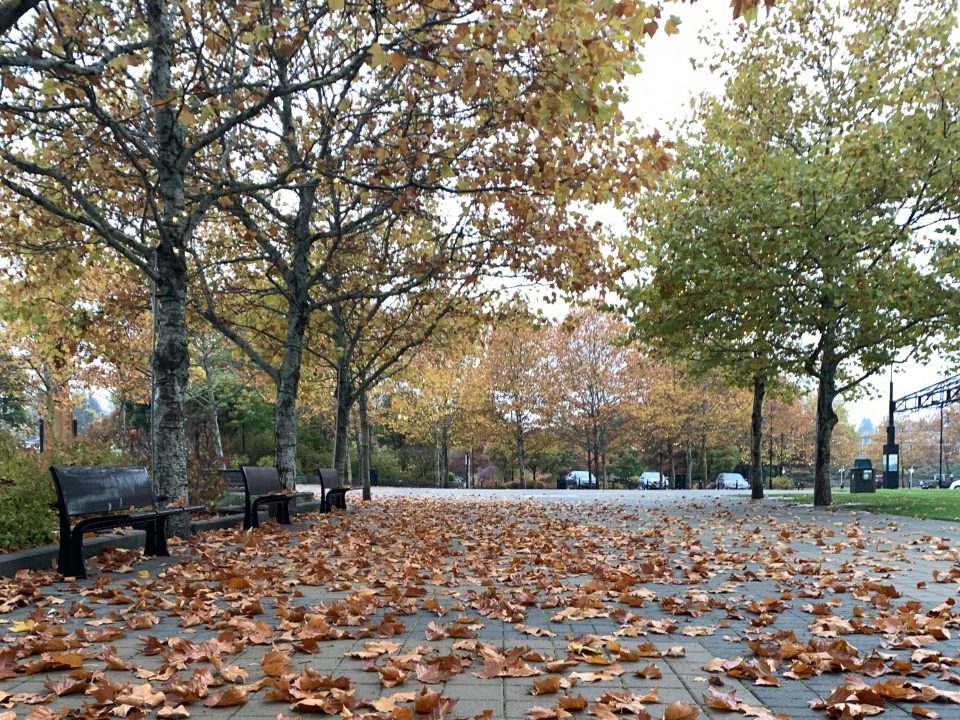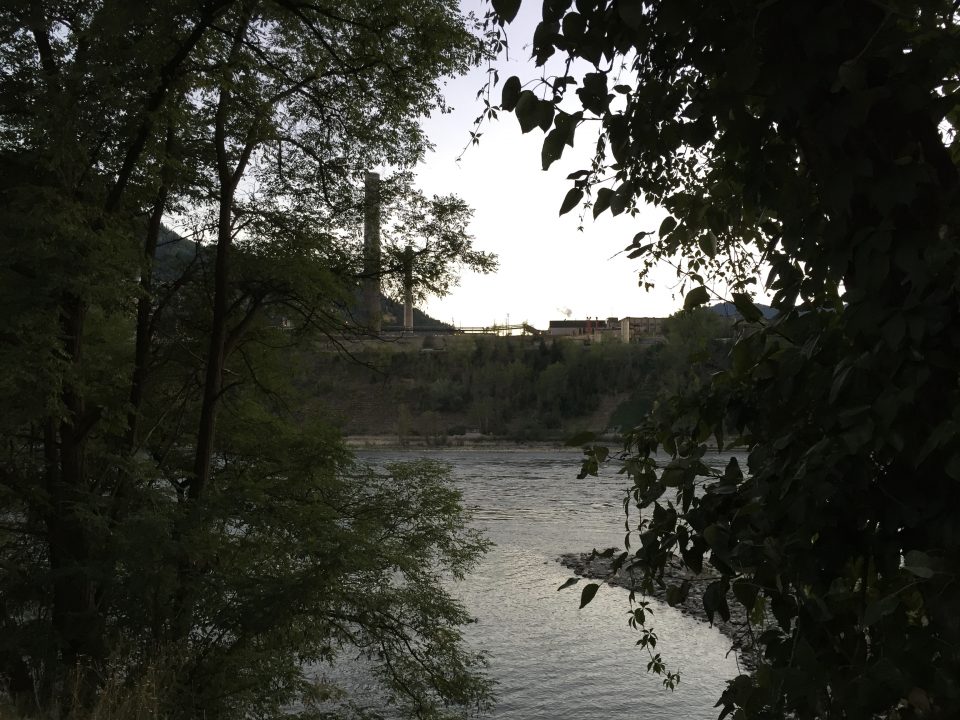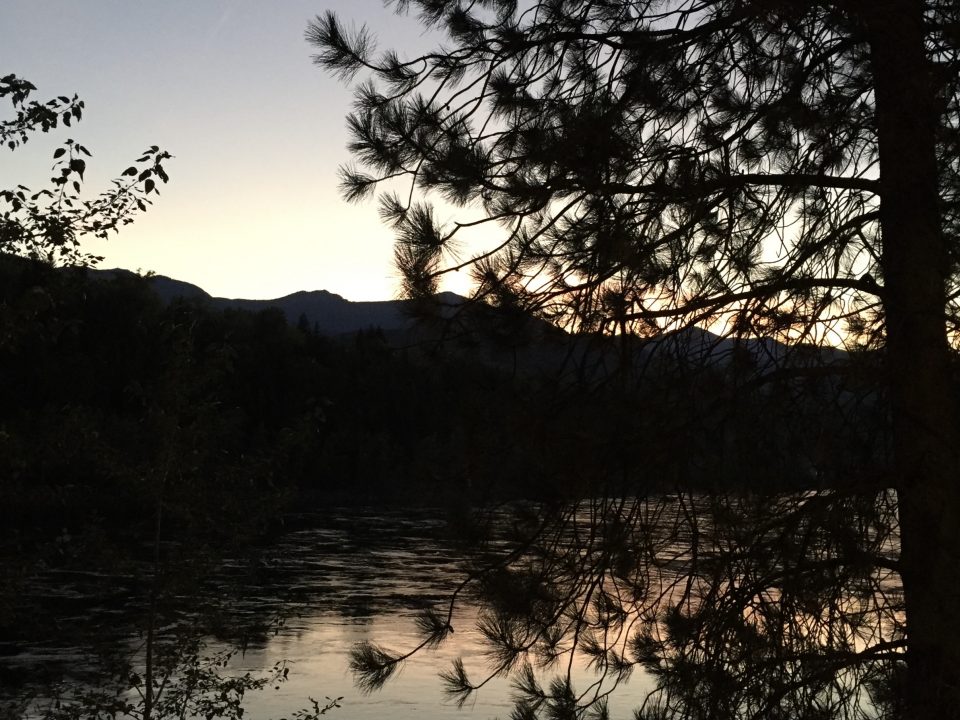The Holiness of Strawberries

Micro-Version:
A church barges its way across the Fraser River, ghosts intact, while the Ladies Guild dines on strawberries and cream. A yogi appears, along with a swallow. Enlightenment is elusive. Still, a seeker seeks.
Long-form version:
There is a historic church in the town I live in. It is the oldest wooden church in British Columbia and it is here where we set our scene.
The tiny white church sits just off of River Road, the third location in its long and well-traveled life, having been rafted over from the once-bustling-then-ghost-town of Derby across the mighty muddy Fraser. As I write this I look across that same river, some 160 years later and can see Derby Reach Park. It is June and the river is full. I cannot help but wonder what strange ghosts traveled with the church timbers in their bold navigation across the water.
One day I drove past the church in my usual way, somewhat absentmindedly, listening to CBC on the car radio and daydreaming about new pajamas and vegetable gardens.
Out of the corner of my eye I caught a glimpse of the priest opening wide the big front doors, heavy on their hand-made hinges, ready to welcome his flock, or the sky, or the big vast world.
The parking lot was empty, no parishioners clamored at the door and yet the priest stood in white and gold robes, and a tall and awful hat, blazing in front of the big brown doors like a holy beacon or a promise of heaven.
Shining in the doorway, with the darkness of the church behind him, the sun caught his robes like fire and I felt myself cry out – a sob caught in my throat and tears, a wet surprise, spilled from my eyes. A longing bigger than the moon filled my chest as I drove on, astonished, past the chestnut trees above the river.
I had not seen that blaze of glory coming.
The same church holds an annual Strawberry Tea. Each June, I drive by the small hand-painted wooden sign perched along the roadside.
A Strawberry Tea is quite irresistible to me, offering as it does the divine sweetness of local berries laced with cream, beaten into luxurious submission by the churchy hands of the members of the Ladies Guild, their mouths set in determination as they whip.
The berries and cream are served with real shortcake, not sponge, on mismatched china plates, set on folding tables covered in cleanly pressed tablecloths and decorated with vases of June flowers – roses, daisies, dahlias, peonies. The vases too, are mismatched, adding a certain festivity to the arrangements.
Then there is the tea itself, steeped in china pots hugged in knitted tea cozies, poured into delicate teacups, set on matching saucers. Great effort and love is put into the finding of matching cups and saucers.
I can see it all, as I drive past, and I decide, this year, to go. I am easily lured by cakes and berries, but I am driven by something deeper. I am fervently looking for another glimpse of the radiant priest.
The tea includes a jumble sale featuring trinkets and treasures gathered from attics and basements and the back corners of sweet smelling drawers. Books and costume jewelry, medals and mismatched china and knitted and crocheted goods: potholders and baby sets, cute bonnets and booties laced with ribbons. I make away with a painted plate, an embroidered dishtowel, a book of Robert Service poems and a brooch made of pewter and green stones.
I have my tea and cake with a woman sitting alone. She appears a commanding sort of person, with a sour face and a cane. She uses the cane to point at people and things, as she tells me the story of her history with the church. She has been a parishioner here since she was a child. I have no trouble imagining her as a girl. A little queen I think, bossy and demanding. Probably not well-liked. Even today, despite her long history here, she is isolated, set apart from the other churchwomen who are humming like bees among the cakes and kettles.
Her legs, I see, are elephantine, underneath the white tablecloth. There is a second cane leaning against the windowpane behind us. She can no doubt hardly walk, and so she is parked here, at a table with a view, attracting the newcomers. I only half-listen to her, as I am distracted by the possibility of the priest and taken back in time by the familiar smell of the church hall, a smell of old carpets mixed with questions and dust, that reminds me of Sunday school.
We were United Church of Canada and my brother and I attended Sunday school mainly for the colouring. I particularly liked colouring pictures of Jesus, his hair always brown, and his robes always blue. As I listen to this bitter matron tell her stories of devotion to the Guild and to god, I am back in the basement of our plain white United Church, all square angles and freedom from decoration. The framed picture of Jesus, looking like a Hollywood star with sad eyes, smiles down at me.
The priest did not appear, and I stayed long enough to eat a second plate of strawberry shortcake and to fetch and carry for my lame companion. I attempted to do so with kindness, although I could see how easily tiresome this could become, and how the church ladies must be worn out from decades of being bossed about, long before the legs were swollen and the canes became instruments of direction. How strained their kindness must become.
Later that summer, I drove past the church again. Sitting in full lotus position on the stoop in front of the wide, brown doors was a yogi. It was a hot day, and the yogi sat in full regalia on the hot cement. Bedecked in crimson, orange and gold, wizened brown face turned to the sun, matted grey hair braided and wrapped in beads and cloth, he sat in silent contemplation.
Could I be sure of what I had seen? I wheeled around, turned back and parked my car at the far end of the empty lot.
The pavement steamed, and the dark yogi made no notice of me. An offering seemed called for. In my car only an unopened bottle of Evian water, and a package of Twizzlers. I make my offering and receive a small brown smile. No words pass between us.
I did not drive past the church again that day, afraid I would see only the brown doors closed, and a water bottle and unopened package of candy littering the step.
What do they want from me, these holy men in their bold robes? I know what I want from them. I want to pour my doubts into them, and have my sins washed away like a holy blessed dream.
Instead I offer bottled water, candy, and a bent sort of kindness to crippled strangers. I have yet to see again that white-robed priest or glorious yogi, the light and dark of the same coin.
Much later, I attended this church to comfort a friend who’d lost her mother. The church itself, once you pass through the dark vestibule is a small chamber of wood and sunbeams. Diamond-paned windows shine perfect light onto the oaken altar. The brass eagle lectern gleams. Angels and ghosts breathe themselves into the corners of the arched ceiling, while the clergy who presides over the service, a straightforward portly woman, offers fond words about the departed into the sacred air.
Leaving the church that day, I looked up into the belfry. A winter sparrow darted across the sky.
Thoughts on this post? Please do comment below.
A church barges its way across the Fraser River, ghosts intact, while the Ladies Guild dines on strawberries and cream. A yogi appears, along with a swallow. Enlightenment is elusive. Still, a seeker seeks.
Long-form version:
There is a historic church in the town I live in. It is the oldest wooden church in British Columbia and it is here where we set our scene.
The tiny white church sits just off of River Road, the third location in its long and well-traveled life, having been rafted over from the once-bustling-then-ghost-town of Derby across the mighty muddy Fraser. As I write this I look across that same river, some 160 years later and can see Derby Reach Park. It is June and the river is full. I cannot help but wonder what strange ghosts traveled with the church timbers in their bold navigation across the water.
One day I drove past the church in my usual way, somewhat absentmindedly, listening to CBC on the car radio and daydreaming about new pajamas and vegetable gardens.
Out of the corner of my eye I caught a glimpse of the priest opening wide the big front doors, heavy on their hand-made hinges, ready to welcome his flock, or the sky, or the big vast world.
The parking lot was empty, no parishioners clamored at the door and yet the priest stood in white and gold robes, and a tall and awful hat, blazing in front of the big brown doors like a holy beacon or a promise of heaven.
Shining in the doorway, with the darkness of the church behind him, the sun caught his robes like fire and I felt myself cry out – a sob caught in my throat and tears, a wet surprise, spilled from my eyes. A longing bigger than the moon filled my chest as I drove on, astonished, past the chestnut trees above the river.
I had not seen that blaze of glory coming.
The same church holds an annual Strawberry Tea. Each June, I drive by the small hand-painted wooden sign perched along the roadside.
A Strawberry Tea is quite irresistible to me, offering as it does the divine sweetness of local berries laced with cream, beaten into luxurious submission by the churchy hands of the members of the Ladies Guild, their mouths set in determination as they whip.
The berries and cream are served with real shortcake, not sponge, on mismatched china plates, set on folding tables covered in cleanly pressed tablecloths and decorated with vases of June flowers – roses, daisies, dahlias, peonies. The vases too, are mismatched, adding a certain festivity to the arrangements.
Then there is the tea itself, steeped in china pots hugged in knitted tea cozies, poured into delicate teacups, set on matching saucers. Great effort and love is put into the finding of matching cups and saucers.
I can see it all, as I drive past, and I decide, this year, to go. I am easily lured by cakes and berries, but I am driven by something deeper. I am fervently looking for another glimpse of the radiant priest.
The tea includes a jumble sale featuring trinkets and treasures gathered from attics and basements and the back corners of sweet smelling drawers. Books and costume jewelry, medals and mismatched china and knitted and crocheted goods: potholders and baby sets, cute bonnets and booties laced with ribbons. I make away with a painted plate, an embroidered dishtowel, a book of Robert Service poems and a brooch made of pewter and green stones.
I have my tea and cake with a woman sitting alone. She appears a commanding sort of person, with a sour face and a cane. She uses the cane to point at people and things, as she tells me the story of her history with the church. She has been a parishioner here since she was a child. I have no trouble imagining her as a girl. A little queen I think, bossy and demanding. Probably not well-liked. Even today, despite her long history here, she is isolated, set apart from the other churchwomen who are humming like bees among the cakes and kettles.
Her legs, I see, are elephantine, underneath the white tablecloth. There is a second cane leaning against the windowpane behind us. She can no doubt hardly walk, and so she is parked here, at a table with a view, attracting the newcomers. I only half-listen to her, as I am distracted by the possibility of the priest and taken back in time by the familiar smell of the church hall, a smell of old carpets mixed with questions and dust, that reminds me of Sunday school.
We were United Church of Canada and my brother and I attended Sunday school mainly for the colouring. I particularly liked colouring pictures of Jesus, his hair always brown, and his robes always blue. As I listen to this bitter matron tell her stories of devotion to the Guild and to god, I am back in the basement of our plain white United Church, all square angles and freedom from decoration. The framed picture of Jesus, looking like a Hollywood star with sad eyes, smiles down at me.
The priest did not appear, and I stayed long enough to eat a second plate of strawberry shortcake and to fetch and carry for my lame companion. I attempted to do so with kindness, although I could see how easily tiresome this could become, and how the church ladies must be worn out from decades of being bossed about, long before the legs were swollen and the canes became instruments of direction. How strained their kindness must become.
Later that summer, I drove past the church again. Sitting in full lotus position on the stoop in front of the wide, brown doors was a yogi. It was a hot day, and the yogi sat in full regalia on the hot cement. Bedecked in crimson, orange and gold, wizened brown face turned to the sun, matted grey hair braided and wrapped in beads and cloth, he sat in silent contemplation.
Could I be sure of what I had seen? I wheeled around, turned back and parked my car at the far end of the empty lot.
The pavement steamed, and the dark yogi made no notice of me. An offering seemed called for. In my car only an unopened bottle of Evian water, and a package of Twizzlers. I make my offering and receive a small brown smile. No words pass between us.
I did not drive past the church again that day, afraid I would see only the brown doors closed, and a water bottle and unopened package of candy littering the step.
What do they want from me, these holy men in their bold robes? I know what I want from them. I want to pour my doubts into them, and have my sins washed away like a holy blessed dream.
Instead I offer bottled water, candy, and a bent sort of kindness to crippled strangers. I have yet to see again that white-robed priest or glorious yogi, the light and dark of the same coin.
Much later, I attended this church to comfort a friend who’d lost her mother. The church itself, once you pass through the dark vestibule is a small chamber of wood and sunbeams. Diamond-paned windows shine perfect light onto the oaken altar. The brass eagle lectern gleams. Angels and ghosts breathe themselves into the corners of the arched ceiling, while the clergy who presides over the service, a straightforward portly woman, offers fond words about the departed into the sacred air.
Leaving the church that day, I looked up into the belfry. A winter sparrow darted across the sky.
Thoughts on this post? Please do comment below.



